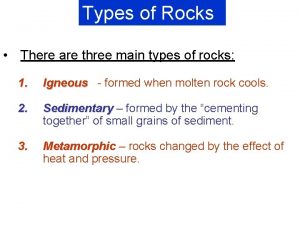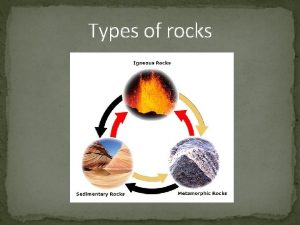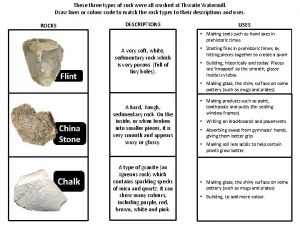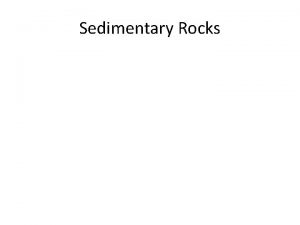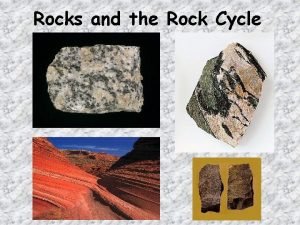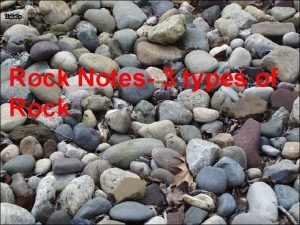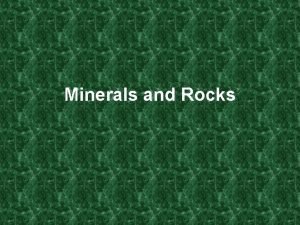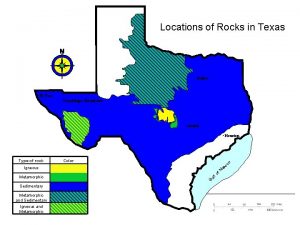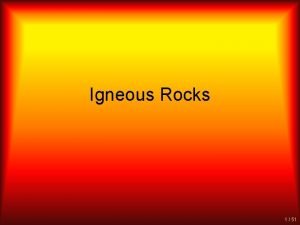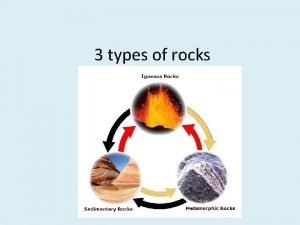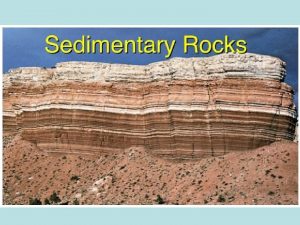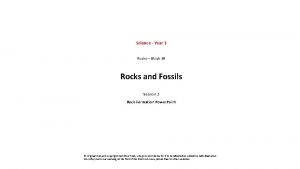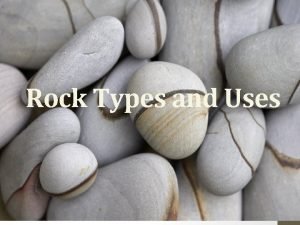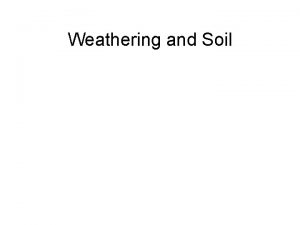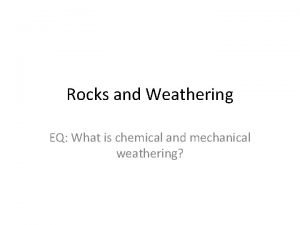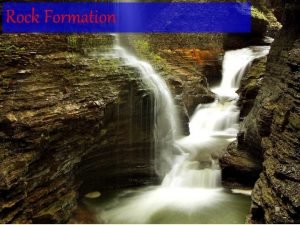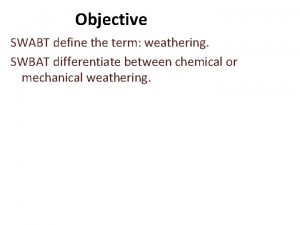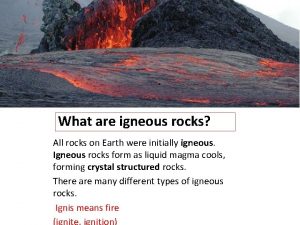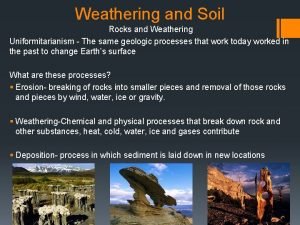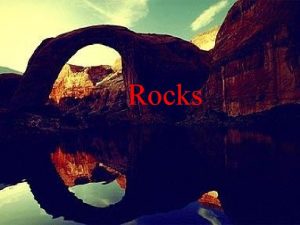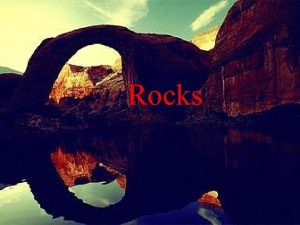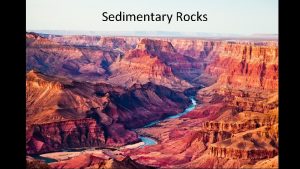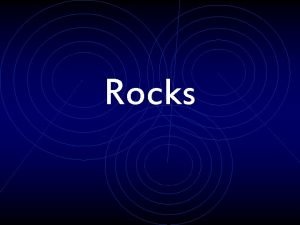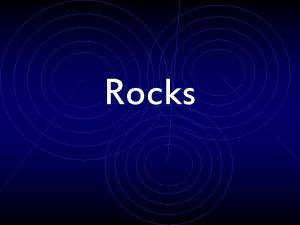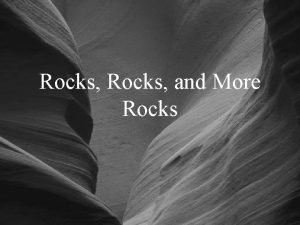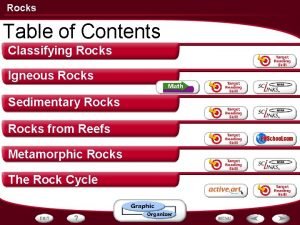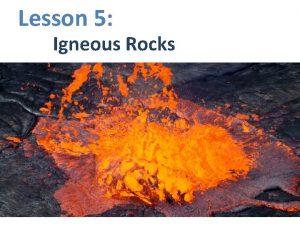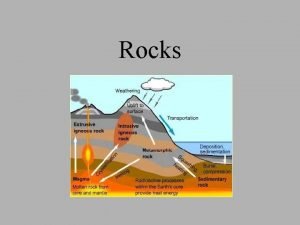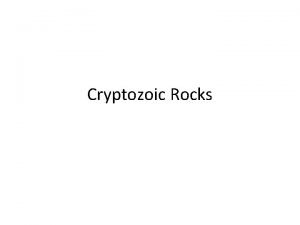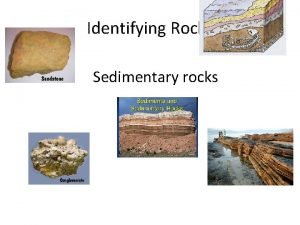3 types of rocks 3 types of rocks



































- Slides: 35

3 types of rocks

3 types of rocks • There are 3 types of rocks found on Earth: – Igneous – Sedimentary – Metamorphic • Knowing the differences between these 3 types of rocks allows us to learn about Earth’s past.

Igneous Rocks - Formation • Igneous Rocks are formed by melting, cooling, and crystallization of other rocks. • Igneous rocks form as a result of volcanic activity, hot spots, and melting that occurs in the mantle.

Igneous rocks • Igneous rocks are common along plate boundaries or mantle hot spots

Igneous Rocks - Classification • Igneous rocks are classified using their texture in the following ways: – – Glassy Aphanitic (no visible crystals) Phaneritic (visible crystals) Porphyritic (Some visible and some not visible crystals)

Igneous Rocks - Texture • Crystal size is used to classify igneous rocks. • Crystals form as the rock cools, and the crystal size can tell us a lot about its cooling history: – The larger the crystals, the slower it cooled.

Igneous Rocks - Texture • Glassy igneous rocks have no crystal structure, and probably formed by very rapid cooling (such as on the surface of a lava, or when a lava enters the water. )

Igneous Rocks - Texture • Aphanitic rocks have no visible crystals, and probably formed by fast cooling above ground.

Igneous Rocks - Texture • Phaneritic rocks have visible crystals, and probably formed by slow cooling below ground.

Igneous Rocks - Texture • Porphyritic rocks have both visible and nonvisible crystals, and probably formed by two different cooling events.

Igneous Rocks - Classification • Dark igneous rocks are formed from basaltic or mafic magma. (Mafic because it contains a lot of magnesium and iron). • The magma that forms these rocks is usually very hot (around 1000°C) and viscous (about the same viscosity as ketchup. )

Igneous Rocks - Classification • Light colored igneous rocks are formed from silicic (high silica content) or felsic magmas. • The magmas that form these rocks is usually more cool, (lower than 850°C), and more viscous (about the viscosity of peanut butter. )

Igneous rocks - Formations • Structures and formations seen in igneous rocks include: – Hexagonal columnar joints – Pahoehoe lava flows – Dikes, sills, and batholiths (plutons) – Pillow basalts – Volcanoes

Igneous Rocks - Examples • The most common types of igneous rocks include: – – – Rhyolite Andesite Basalt Granite Diorite Gabbro

Igneous rocks charted

Igneous rocks - Story • What do you know about the history of the Earth in the place where this rock was found?

Sedimentary Rocks - Formation • Sedimentary rocks are formed by weathering, erosion, deposition, compaction, and cementation of other rocks. • Sedimentary rocks form in areas where water, wind, or gravity deposit sediments.

Sedimentary rocks - formation • Sedimentary rocks are likely to form in areas such as: – – – – Deltas Beaches Rivers Glaciers Sand dunes Shallow seas Deep oceans

Sedimentary rocks - Classification • Sedimentary rocks are classified into two groups: – Clastic rocks – Chemically formed rocks

Sedimentary rocks – Classification • Sedimentary rocks are Clastic if they are made of pieces of other rocks that have been weathered and eroded. • Clastic rocks are grouped based on the size of grain that they are made from.

Sedimentary rocks - Classification • Very small particles make up mudrock. • Medium sized particles make up sandstone. • Large particles make up conglomerates.

Sedimentary rocks - Classification • Sedimentary rocks that form from chemical processes are called biochemical rocks (formed from living things) or Chemical precipitates (formed from lakes or shallow seas. )

Sedimentary rocks - formations • Structures and formations seen in sedimentary rocks include: – – – Stratification Cross bedding Graded bedding Ripple marks Mud cracks Fossils

Sedimentary rocks - Examples • Some of the most common types of sedimentary rocks include: – – – – Conglomerate Sandstone Shale Limestone Gypsum Oolites Chert (including black flint and red jasper)

Sedimentary rocks - Story • What do you know about the history of the Earth in the place where this rock was found?

Metamorphic rocks - Formation • Metamorphic rocks are formed by heat and pressure changing one type of rock into another type of rock. • Metamorphic rocks form near lava intrusions, at plate subduction zones, and in deep mountain roots.

Metamorphic rocks - Formation • Lava intrusions can provide heat that causes metamorphic rocks to form. These small areas of metamorphic rock form from contact metamorphosis.

Metamorphic rocks - Formation • Rocks that metamorphose because of increasing heat and pressure found at plate subduction zones and in deep mountain roots form large areas of metamorphic rock through regional metamorphosis.

Metamorphic rocks - Classification • Metamorphic rocks are classified into 2 major groups: – Foliated – Nonfoliated

Metamorphic rocks - Classification • Foliated rocks form when differential pressure causes minerals to form in layers. • These rocks will have stripes or planes that they will break easily along. • These “stripes” don’t usually line up with the original bedding planes in sedimentary rocks.

Metamorphic rocks • Nonfoliated metamorphic rocks formed in areas where the pressure from all sides was equal, so there is no “linear” quality to the rocks.

Metamorphic rocks - Formations • Structures and formations seen in metamorphic rocks include: – – Folding Plastic deformation Stretching Alternating dark and light layers (gneissic foliation)

Metamorphic rocks - Examples • Some common types of metamorphic rock include: – – – – Slate Schist Gneiss Amphibolite Marble Quartzite Metaconglomerate

Metamorphic rocks - Charted

Metamorphic rocks - story • What do you know about the history of the Earth in the place where this rock was found?
 Sedimentary rock song
Sedimentary rock song Igneous rocks metamorphic rocks and sedimentary rocks
Igneous rocks metamorphic rocks and sedimentary rocks Extrusive rock
Extrusive rock Volcanic rocks and plutonic rocks
Volcanic rocks and plutonic rocks Types of rock quiz
Types of rock quiz What type of rock is this
What type of rock is this Three types of rocks
Three types of rocks Indiana limestone
Indiana limestone Esrt sedimentary rocks
Esrt sedimentary rocks Three types of rocks
Three types of rocks What are the 3 types of rocks
What are the 3 types of rocks The rock cycle foldable
The rock cycle foldable Classification of rocks concept map
Classification of rocks concept map Luster of igneous rocks
Luster of igneous rocks Sedimentary rocks in texas
Sedimentary rocks in texas Elements look like
Elements look like 3 categories of rocks
3 categories of rocks Types of sedimentary rocks
Types of sedimentary rocks Different types of rocks year 3
Different types of rocks year 3 Rock types
Rock types Rock cycle crayon lab answer key
Rock cycle crayon lab answer key Rocks and minerals song
Rocks and minerals song What are the three main types of weathering?
What are the three main types of weathering? Kinds of weathering
Kinds of weathering Properties of sedimentary rock
Properties of sedimentary rock Rock cycle foldable
Rock cycle foldable What is swabt
What is swabt Rock cycle diagram class 7
Rock cycle diagram class 7 Metamorphic rocks with a layered or banded look are called
Metamorphic rocks with a layered or banded look are called Achan pile of rocks
Achan pile of rocks Ignition rocks
Ignition rocks Breaks down rocks
Breaks down rocks Deposition
Deposition Uniformitarianism examples
Uniformitarianism examples Sedimentary weathering
Sedimentary weathering Scientists recently discovered that rocks collected
Scientists recently discovered that rocks collected




